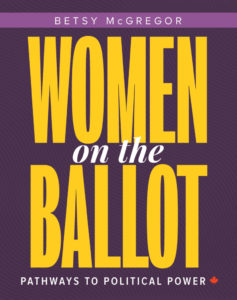 It is an unfortunate fact that there have been more MLAs named John elected to Nova Scotia’s provincial legislature than there have been women. Women on the Ballot: Pathways to Political Power (Rubicon, 2019) bills itself as an “essential roadmap” to correct this imbalance by empowering women to run for political office.
It is an unfortunate fact that there have been more MLAs named John elected to Nova Scotia’s provincial legislature than there have been women. Women on the Ballot: Pathways to Political Power (Rubicon, 2019) bills itself as an “essential roadmap” to correct this imbalance by empowering women to run for political office.
Author Betsy McGregor ran for Liberal nominations three times and for Parliament twice. I have also run as both a federal and provincial NDP candidate and can say that many of the experiences and insights shared throughout this book ring true. McGregor interviewed more than 90 women with experience at all levels of politics. She spoke to Liberals, Conservatives, and New Democrats—from women of experience like Alexa McDonough, the first woman leader of the Nova Scotia NDP, and Hazel McCallion, Mississauga’s longest-serving mayor, to Roseanne Archibald, the youngest Chief at 23 years, and Farheen Khan, the only hijab-wearing woman to run during the 2015 federal election campaign.
The women interviewed offer up honest appraisals of the difficulty of this work, talking frankly about the ways in which it is physically, mentally, and emotionally demanding, insight that we seldom hear about outside of political circles. Libby Davies, former NDP MP, for example, describes her relief upon her decision to retire from politics:
“I was so tired when it was all over. I had no idea how draining flying back and forth from Ottawa to BC was for 18 years—spending the weekends in the constituency attending events and meeting with people. It was gruelling. I had no idea the toll it had taken on me over time.”
Through the interviews, women share their struggle to balance their personal and professional priorities, travelling and attending events with their children in tow, and the physical wear and tear of weeks of door-to-door canvassing during elections.
The book is divided into four sections: making the decision to run, understanding the nomination and campaign process, surviving the particular challenges of being a woman in politics, and thinking about the changes required in our current political system.
McGregor’s analysis in her introductions to each section are where the real gems lie: her assertion that political decisions reach into every aspect of our daily lives; the impact of the gender wage gap on women’s participation in politics; her response to the question of whether it is possible for women to have it all (spoiler: the answer is no); and the essential insight that, in order for meaningful change to occur, the political system itself must change.
The roadmap included in the post script is perhaps a more revolutionary tool than might be immediately obvious. This is practical information that is essential to making an informed decision to run and beginning to mount a campaign. McGregor provides advice on how to recruit a campaign team, the steps required to be declared as a candidate, and the key activities required during a campaign period. This information has traditionally been meted out by party insiders—those gatekeepers who may not see “candidate material” when they look at a young woman in a hijab or an older trans woman.
It is clearly important to make space to explore and understand the experience of women who have put their names forward to run. As Nicole Sarauer, former interim leader of the Saskatchewan NDP describes in Women on the Ballot, “The political space seems reserved for others. Stepping into that space seems like intruding.” McGregor’s goal is clearly to situate aspiring politicians within a different political pantheon (with nary a John in sight).
Although this book provides an important contribution to the conversation about women’s experience in political life, it falls a little short of the loftier goal alluded to in the title. Without more analysis from McGregor, the interviews themselves merely hint at what is needed to clear those pathways to political power. I think readers may be left with the question of why, with this history of women’s political participation, our legislatures continue to be what Nahanni Fontaine describes in the book as a “profoundly white male space.”
What is the urgent work we must do to change the fact that, at current rates, we are still a hundred years away from gender parity? I am confident that answers can be drawn from the experiences documented in Women on the Ballot. I wish McGregor provided a deeper analysis to help us move further along the path from recognizing women’s experiences and contributions, to dismantling the patriarchal structures and systemic barriers that stand between women and political power.

